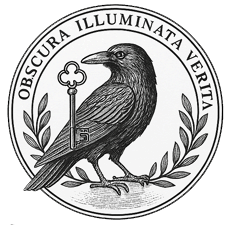Between 1865 and 1984, StormCroft Ltd. operated out of a secluded Victorian estate near Princetown, Devon. To the public, they were an eccentric but ambitious signal technologies company. Behind sealed doors and encrypted journals, however, StormCroft was something far more complex. The inventions listed here—public, secret, and otherwise—form only part of what has been uncovered. Even now, it is unknown how many of their devices still operate… or remember.
An Insight into the History of StormCroft Inventions (1865–1984)
“Not every invention is meant to be useful. Some are meant to be warned against.”
— Graeme Fall, StormCroft Internal Report, 1931
Origins (1865–1889): The Gentlemen’s Workshop
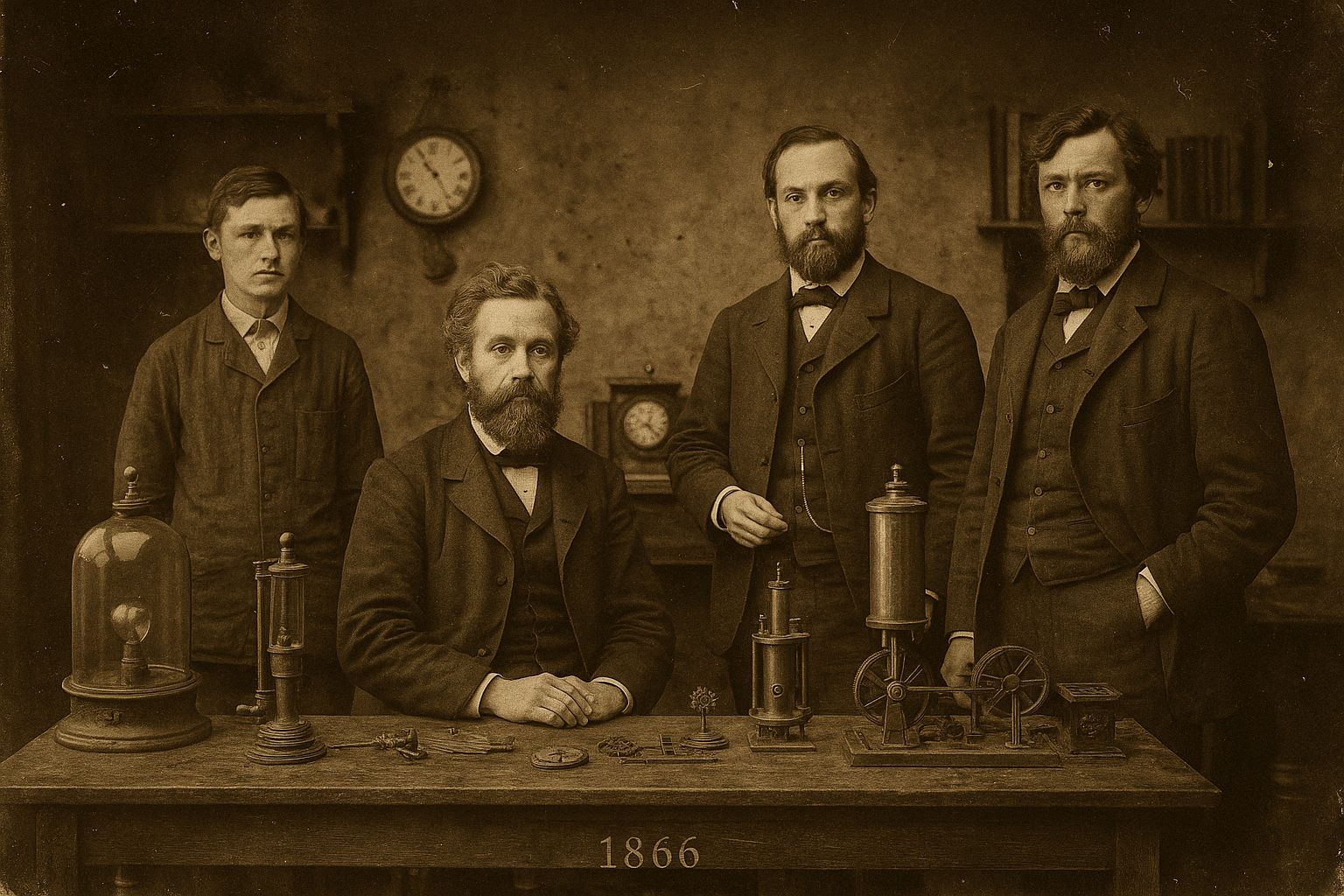
An original 1866 photograph showing StormCroft’s founding minds — including Thaddeus Bellamy and Nathaniel Horne — alongside two early collaborators. The young assistant, believed to be Elias Dunbridge, would later become StormCroft’s first archivist. Early prototypes rest on the workbench in the Langport weighhouse. Right – Nathaniel Horne (1828–disappeared 1872)
An engineer and investor in crystal diodes, he built Bartram’s Compass, removed from public knowledge after users reported becoming disoriented even in familiar places.
After a failed demonstration of Pressure Box II, he vanished en route to Bristol. Only his luggage was found. A small box of lead filings and twine remained, with a note:
“Don’t send it back to where it’s from. It already knows the way.”
Left (Standing) – Elias Dunbridge (1850–1911)
Then a 16-year-old firebox tender, Dunbridge later became StormCroft’s first Archivist. He documented and stored most early anomalous devices and created Box 12, the original Containment Room.
He died blind in 1911, reportedly after removing his own eyes with a folded field map. When unfolded later, the map bore a new inscription:
“I can still see it ticking beneath the floor.”
Far Right – “Howard Brill” (believed pseudonym) (?–?)
His name appears in no records. His face—long assumed a mistake—was later found etched into the casing of the Residual Clock. In 1884, Archivist Agnes Well marked his file:
“Do not say his name aloud. He might never have left.”
An original photograph dated April 2nd, 1866, captures StormCroft’s earliest minds — including the enigmatic Thaddeus Bellamy and reclusive engineer Nathaniel Horne — alongside two unnamed collaborators whose records remain fragmentary. Most notable is the presence of a teenage assistant, widely believed to be Elias Dunbridge, who would go on to become StormCroft’s first official Archivist and the initiator of the Box 12 system. The image, shot in long exposure, shows early prototypes scattered across the workbench in the dim interior of the Langport weighhouse — including what is now believed to be the casing for the Sounded Threading Wheel and an incomplete tuning structure bearing reversed etchings.
StormCroft Inventions began quietly in 1865, formed by a small, secretive band of polymaths, fringe engineers, and what some referred to as spiritual mechanists — individuals who saw no contradiction between empirical study and the exploration of metaphysical causality. Their base of operations was a disused agricultural weighhouse near Langport, Somerset, chosen for its seclusion, thick stone walls, and a cellar room that allegedly produced sympathetic vibrations at irregular intervals — a phenomenon that would later inspire the first tests of the Listening Floor concept.
Initially operating under the name The Gentlemen’s Workshop of Applied Curiosity, the group maintained strict anonymity and never advertised. Instead, they communicated through personal letters, sealed boxes of schematic fragments, and word-of-mouth among like-minded scholars. Their goals, recorded in the Langport Statement (a wax-sealed parchment later found stitched into a servant’s coat), were threefold:
-
To investigate mechanical manifestations of unseen phenomena, particularly those believed to correlate with intuition, ritual, or dreams
-
To preserve artefacts and devices that “should not have worked,” including those whose function defied explanation or whose operation could not be repeated under controlled conditions
-
To document inventions believed to arise without deliberate intention — devices dreamt, imagined in illness, or sketched in moments of trance-like cognition
From this vision, several remarkable prototypes emerged in the early years, including the Tuned Morse Fork — a brass bifurcated rod that responded not to electrical impulses but to spoken intent in Morse cadence; the Sounded Threading Wheel — a rotating spool that emitted tones when passed over specific materials, especially faded cloth; and Bartram’s Compass — a directional instrument that, rather than pointing north, was said to orient toward “zones of unnatural silence,” an idea later foundational to StormCroft’s acoustic triangulation experiments.
Aftermath and Suppression
What began as an exploratory haven soon drew suspicion — not from the public, who remained unaware, but from within. By 1870, StormCroft’s internal unity had begun to fray. A growing schism divided the collective between two opposing factions:
-
The Practical Wing, led by Bellamy and others, who wished to develop select devices into usable technology or discreetly influence public applications
-
The Preservationists, who believed that many inventions carried latent properties that could not be safely replicated, let alone shared
A series of incidents hastened the rift — most notably, a near-fatal episode involving an early prototype of Pressure Box I and the unexplained activation of the Threading Wheel during a thunderstorm, which caused all inked text in the workshop ledger to fade simultaneously.
Within five years of the founding photograph:
-
The Langport weighhouse was condemned after structural irregularities and unexplained subsidence, later attributed to “ground memory leakage” in internal memos
-
Several devices were sealed in paraffin-lined crates and tagged with hand-inked warnings: “No further inquiry. Auditory trace residual.”
-
The original photograph, once used to confirm workshop membership, was reclassified under LATCHGATE MEMORY REFLEX – CATEGORY D, a designation reserved for physical items known to stimulate recollection of events the viewer never experienced
-
Only a single print remains today. Stored in controlled silence, archivists note that when viewed for more than ten seconds without ambient sound, the boy in the image — believed to be Dunbridge — appears to blink.
Some now believe the photograph itself may have absorbed a residual field from one of the early experiments — perhaps the so-called “intent coils” used in the Tuned Morse Fork. Others maintain it is simply an effect of prolonged exposure and human imagination. Regardless, the image remains sealed in a frost-glass case under quiet rotation, never left in darkness, and never entirely still.
The Expansion Era (1890–1923): The Age of Paradoxical Utility
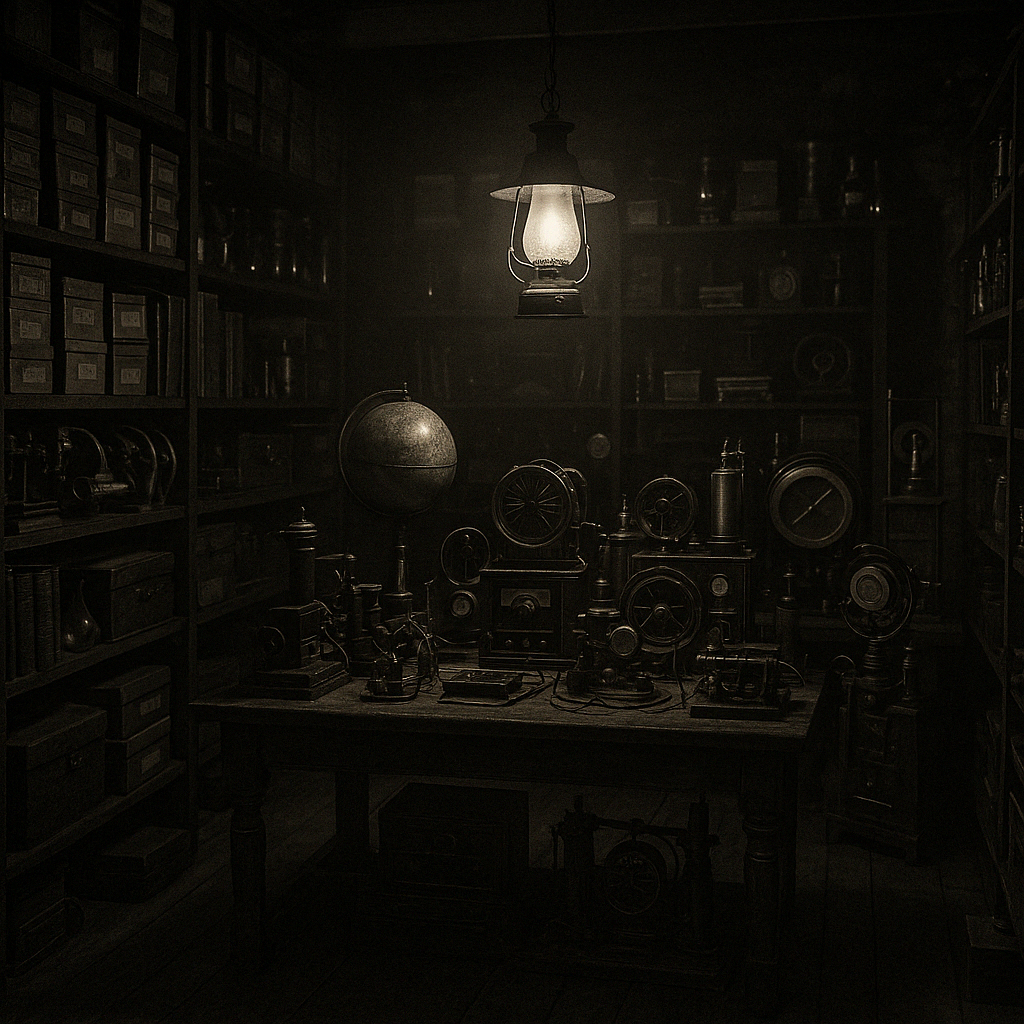
A rare glimpse inside the StormCroft archive during its prolific Expansion Era, this image captures a table of classified experimental devices, catalogued in dim lamplight. Each item shown was designed not to solve problems — but to reveal them.
A dimly lit table, deep within a windowless chamber beneath Exeter, displays an array of classified experimental devices. Some appear cobbled together from scavenged gramophones and clockwork parts; others are impossibly intricate, their purpose unclear even to those who assembled them. Each device was designed not to solve problems in the conventional sense, but rather to illuminate them — to expose unseen tensions, submerged thoughts, or the hidden architecture of human perception.
By the early 20th century, StormCroft had transitioned from clandestine curiosity to controlled dissemination. No advertisements, no exhibitions — but whispers spread. Their influence unfurled not through public endorsement but via covert insertions into scholarly journals, margin-glossed blueprints passed between trusted academics, and spoken lectures given in backrooms under assumed names. A common format was the “Select Supplement,” a folded diagram slipped into otherwise unremarkable periodicals, accessible only through a ciphered page number or a seemingly unrelated footnote.
In 1897, seeking both discretion and additional space, the group vacated Langport entirely. They established a new archive beneath a decommissioned brewery in Exeter. Its cooling tunnels and thick stone fermenting vaults made it ideal for containment and sensory isolation. The air was always damp, the walls never fully dry. Certain rooms were said to amplify echoes days later, and it was here that the first Controlled Perception Environment (CPE) was constructed — a chamber for observing how devices responded not to input, but to prolonged observation.
Among the more cryptic and controversial inventions to emerge from this period were:
-
Residual Clock – A tall, faintly humming timepiece that measured not linear time but what its creator called “memory pressure” — an emotional density reportedly altered by the recollection of suppressed or forgotten moments. Its hands moved backwards in the presence of certain visitors.
-
Sleepless Bell – An alarm device that activated not when danger approached, but only when no immediate threat was detected. It was used once, mistakenly, in a nursing ward. One patient reportedly cried out, “It’s ringing because we’re not afraid. That’s when it comes.”
-
Nightrift Recorder – A wax-cylinder phonograph that recorded utterances made during unconscious states — sleep, trance, or severe distraction. In one instance, it captured a full conversation between two people who were not present, in a dialect no linguist could trace. The original recording has since deteriorated, though fragments remain in Box 7-C.
Devices from this era were no longer mere experiments in signal or structure — they had become philosophical objects, arguments made physical. StormCroft’s machines no longer asked “What can we do?” but “What can be perceived?” and, increasingly, “What perceives us in return?”
Engineers of this period rarely called themselves inventors. They became known internally as Listeners, Formatters, and Custodians of Device Behaviour. It was a time of uncertainty, but also of flourishing strangeness — where tools were built to measure phenomena yet unnamed, and every spark of intuition was treated as a potential schematic.
The Quietening (1924–1957): Suppression and Division
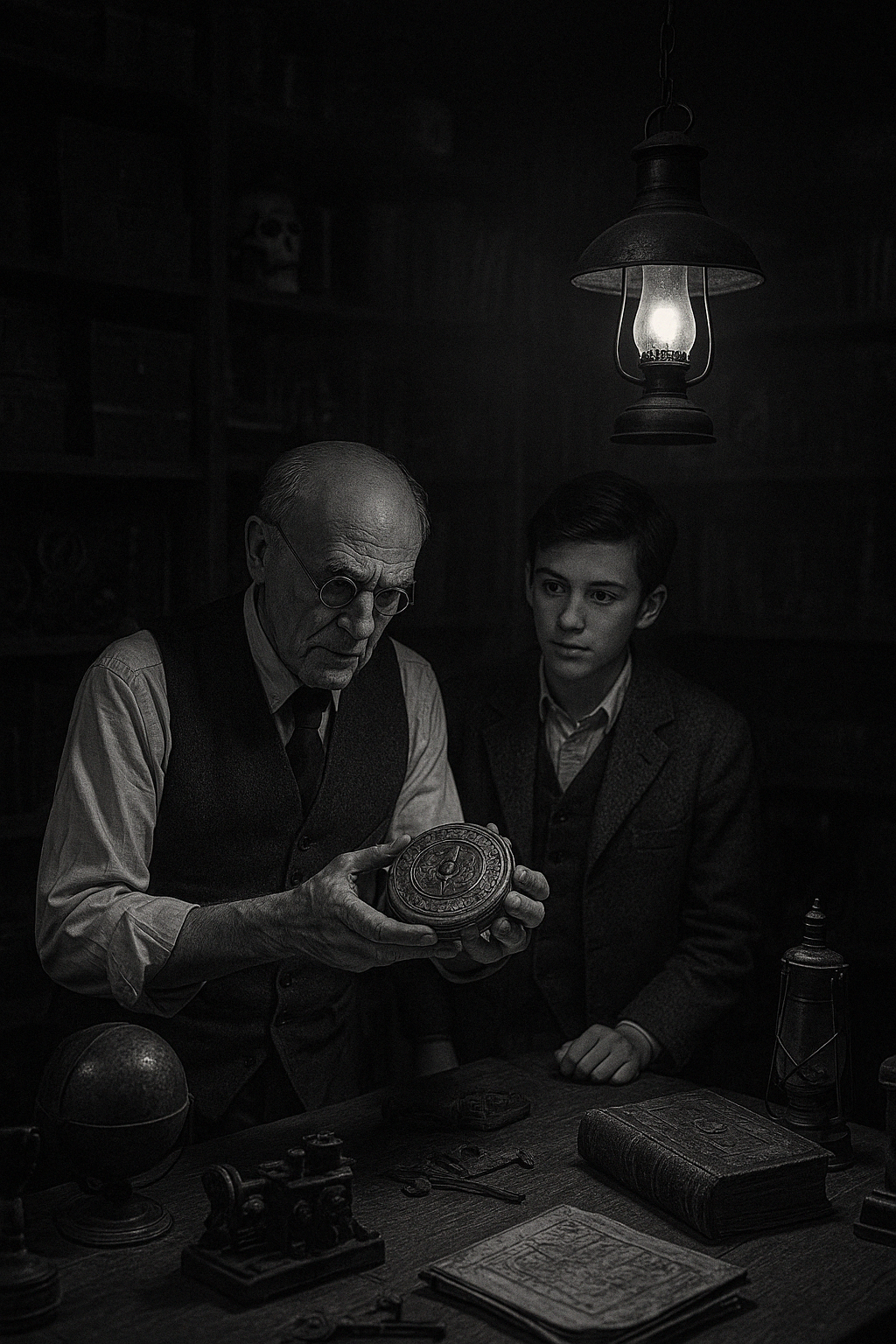
Under the flicker of a single oil lamp, a senior StormCroft archivist examines a restricted artifact from the Quietening Era, observed by his young aide. These final assessments, often done without written record, were part of a shift from invention to isolation — when devices were no longer tested, but quietly sealed.
Under the amber flicker of an oil lamp, a senior archivist crouches in the silence of Archive Room Delta. Dust coats every surface. On the desk before him rests a sealed artifact — warped slightly from age, but unmistakably humming at the edge of perception. A young aide watches intently, pen hovering above a blank page that will remain unwritten. By this stage in StormCroft’s history, devices were no longer tested, let alone discussed. They were locked away, labelled with increasingly vague identifiers, and reviewed only under special instruction.
The Quietening era, which spanned from 1924 to the mid-1950s, marked a fundamental change in StormCroft’s operational ethos. What had begun as a pursuit of invention and perception had evolved — or perhaps devolved — into quiet suppression. The shift can be traced with near precision to a single, disastrous public event: the ill-fated 1924 Baltic Symposium demonstration of the Perceptual Box.
Designed to show visual overlays of ambient thought residue — what some termed psychic echo — the device triggered a temporary shutdown in the frontal reasoning centres of three audience members. One man screamed uncontrollably for forty-seven minutes. Another reportedly lost the ability to distinguish time as sequential. The box was removed mid-demonstration. The incident was dismissed publicly as a “technical malfunction,” but StormCroft’s name vanished from all future proceedings.
In the years that followed, StormCroft withdrew almost entirely from external engagement. Internally, tensions mounted. The most divisive point of contention emerged in 1933 with the launch of the Listening Floor Project — a failed attempt to record auditory emissions from untreated foundation stone beneath the Exeter site. Believed to store trace memory, the stone produced rhythmic pulses when exposed to certain frequencies. Leaked test notes referenced “tones of prior habitation” and “footfall patterns not logged by present staff.”
The Listening Floor Project fractured StormCroft’s Council. While some wished to publish the findings under pseudonym, the prevailing body invoked what became known as The Sealing Doctrine, a directive issued without debate in 1934:
“That which reminds the world of what it ought not know must be archived, not shared.”
— Internal Memorandum 7-R, Council Consensus, March 1934
From that point forward, invention ceased to be StormCroft’s goal. Instead, the organisation reoriented itself as a containment bureau for its own past. Devices that had once been celebrated were boxed, hidden, or irreversibly altered. Some were retrofitted to resemble decorative curios: candlestick receivers, weathered compasses, gilded lighters. Others were stored in lead-lined crates marked only with single glyphs.
Archivists stopped calling the devices by name. Terms like artifact, item, and memory point replaced what had once been titles. Each new generation of staff inherited less detail than the last. By the 1940s, most could no longer explain what the objects had been built to do.
The Quietening Collection — so named for its absolute lack of audio recordings despite numerous contained phonographs — remains among the most elusive chapters in StormCroft’s legacy. The artifacts endure, faintly resonant and meticulously sealed, resting in isolation… yet seemingly aware that they were never truly meant to sleep.
The Final Devices (1958–1984): Misfires and Vanishings
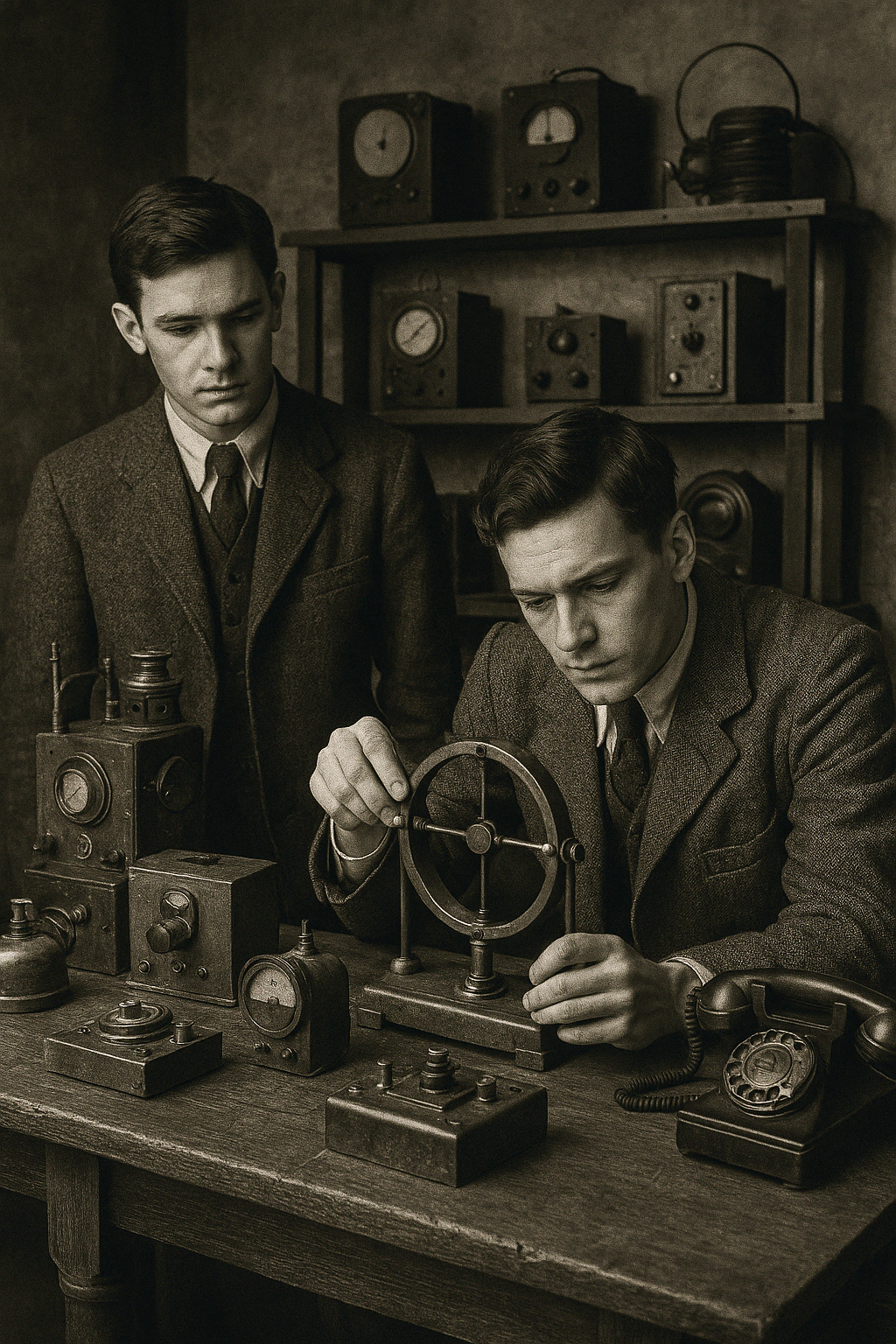
Captured in the twilight years of StormCroft’s innovation era, this image shows junior engineers Martin Lowsley and Elwin Grey inspecting a selection of the last recorded devices. Most were decommissioned due to unexplained behaviour during live testing. Neither man would go on to design again.
As StormCroft entered its twilight years, its experiments grew more unstable, more abstract, and increasingly untethered from reproducible science. Devices were no longer designed with application in mind — if they ever truly had been — but instead emerged from instinct, compulsion, or what some later staff described as “behavioural drafts” formed in liminal states. These final machines did not simply malfunction; they behaved unpredictably, refusing to act the same way twice, or worse — remembering previous interactions.
Among the last known inventions:
-
Syntax Mirror (1958) – A hand-held silver-backed mirror mounted in cast iron, reported to reflect not one’s image, but the residual sound of conversations once held in the room. Audio appeared not as echoes, but as perfectly articulated spoken words, sometimes from individuals no longer alive. The mirror reacted more intensely in locations with documented trauma. It was later sealed in a lined case after a trial user claimed to hear his father respond to an argument he hadn’t yet had.
-
Fenn Recorder (1966) – A low-hum magnetic tape unit fitted into a hand-carved oak housing. It required no power source after initial winding and would play back fragments of whispering speech with no identifiable origin. The volume was fixed. The language, mostly indecipherable, included occasional known names and locations. It was buried in a lead coffin under the Dartmoor perimeter after a continuous 11-day whisper loop refused to cease, even after its mechanical core was removed.
-
Cradle Valve (1984) – A sealed brass chamber, palm-sized, without openings, dials, or obvious components. It was described in internal records only as “an absence dressed in brass.” Weighing exactly one pound in all environmental conditions, the Valve could not be disassembled or X-rayed. When held by human hands, it produced a mild sensation of spatial nausea. No known function was ever ascribed to it. It was the final recorded device to be built at StormCroft before the last documented closure of the Archive Assembly.
The Final Devices – Martin & Elwin, 1963
A now-faded photograph taken in 1963 shows junior engineers Martin Lowsley and Elwin Grey examining a set of decommissioned equipment on an evaluation table. The caption — long since torn from the file index — simply reads: “If they blink, leave the room.”
Neither man would design again. The image marks one of the last known appearances of StormCroft’s engineering division before the full onset of the Quiet Protocols.
Personnel Files: Martin Lowsley & Elwin Grey
Classification: Archive Series V, Final Devices Division
Disposition: Inactive / Unverified
Martin Lowsley (b. 1937 – disappeared 1971)
Lowsley joined StormCroft in 1959 after completing an internship at the Northern Instruments Institute in Sheffield, where he was noted for constructing frequency receivers that responded to Morse inputs even when disconnected. Brought into the Final Devices division under the quiet recommendation of Archivist Elias Dunbridge, Lowsley quickly gained a reputation for his internal precision and his reluctance to speak.
-
Personally restored the Syntax Mirror to partial functionality using a non-repeating solder pattern
-
Assisted in the reassembly of the Cradle Valve, despite no schematic existing
-
Conducted night-time field testing of the Stark Pendulum, a hanging device sensitive to absolute silence and never to be approached after dusk
Internal memos noted that Lowsley experienced increasing withdrawal during his final year. One report by Graeme Fall stated:
“His sketches arrive completed, but he does not recall drawing them.”
Lowsley disappeared in the spring of 1971 after requesting access to the long-shuttered Langport Subvault — an area officially decommissioned in 1946. His coat and journal were found neatly folded outside the perimeter gate. The last page of his notes read only: “Entry is recognition.”
Elwin Grey (1939–1994)
Grey, in contrast, was often referred to as “charmingly skeptical” and had a background in wireless acoustics and field transmission anomalies. He was recruited in 1960 to assist in dismantling the Fenn Recorder but refused to decommission it after claiming to recognise one of the voices it emitted — a teacher from his childhood who had died in 1952.
Grey was a vocal opponent of complete archival destruction. He argued that certain inventions might one day be “contextualised,” if not reactivated safely. This view put him at odds with the rising containment orthodoxies of the period, particularly Graeme Fall’s Doctrine of Irrelevance.
Despite his dissent, Grey was permitted to continue limited correspondence. He maintained personal contact with Brother Malley, a former containment technician turned recluse, and exchanged letters with Agnes Well’s niece, believed to be the last living relative of StormCroft’s original archivist circle.
StormCroft Broadcasting
In 1972, Grey unofficially supported a fringe initiative known as the Devon and Dartmoor Radio Company — a short-lived bid to secure an Independent Local Radio (ILR) licence. The project proposed a broadcasting model based on unconventional signal harmonics, oral folklore, and “resonant night transmissions” inspired by Grey’s own fieldwork.
-
Programme elements included:
-
Local mythography segments with community call-ins
-
“Field acoustics” — live recordings from moorland sites
-
Late-night sequences using undulating frequency shifts derived from the Cradle Valve
-
StormCroft formally disavowed the project, citing “lingering psychoacoustic signature hazards” in the broadcast methodology. The Independent Broadcasting Authority rejected the licence application, stating it lacked clarity and “exhibited excessive reliance on unverifiable source technologies.”
Rumour holds that Grey ran a single test transmission from a converted water tower near Hennock. The original reel-to-reel master, if it exists, has never been located. Grey died in 1994. His will contained a sealed envelope marked “To be opened when the mirror speaks back.”
Relationship Summary
-
Lowsley & Grey: Professional equals, frequent collaborators
-
Grey & Dunbridge: Mutually respectful, philosophically divided
-
Grey & Graeme Fall: Documented tensions over containment
Both men were last linked to devices now sealed under Protocol Room Black-Ash.
Legacy & Present
Today, StormCroft survives in fragments:
-
Burnt schematics
-
Auctioned curios
-
Unlabelled film reels
-
Whispered testimony
Websites like stormcroft.com now attempt to reassemble a puzzle not meant to be solved.
StormCroft File SC-ORIG/1866: The Gentlemen’s Workshop – Founding Circle
Langport Weighhouse, Somerset
Photograph dated: April 2, 1866
Photographer: Unknown, plate signed only “M.H.”
Recovered from a sealed drawer in the condemned eastern wing of the original Langport Archive, this image is now recognised as the earliest surviving photograph of StormCroft’s founding circle. The photograph itself is a glass plate positive, housed in a rust-locked tin box wrapped in thick calico cloth — remarkably intact despite evidence of water ingress and mild warping along the lower frame. A faint chemical bloom obscures part of the top left corner, where the image appears to ripple unnaturally under direct light.
Taken on the second day of April in 1866, it captures four men — three seated, one standing — in a low-roofed timber chamber believed to be the main workshop floor of the Langport weighhouse. Behind them, the crude outlines of early instruments are visible: a spoked assembly ring, a pair of conductive rods lashed together with copper thread, and what appears to be an unfinished chamber with eight inscribed lenses mounted to a rotating wooden base. The expressions of the men range from stoic to withdrawn; only the standing boy, likely Elias Dunbridge at age 16, seems to meet the camera directly.
Though initially dismissed by historians as a curiosity from the era of fringe spiritualism and Victorian phrenology, the photograph has since become a key reference point for tracing the earliest operations of StormCroft. Later marginalia found in internal ledgers and field journals link each of the men pictured to significant anomalies — including three missing persons cases, two containment breaches, and one confirmed temporal echo that disrupted an archive hallway in 1922.
The seated man in the centre, later confirmed to be Thaddeus Bellamy, would die in 1890 under unexplained conditions involving “internal combustion without ignition.” To his right sits Nathaniel Horne, who disappeared in 1872 and was last seen boarding a train that arrived empty. The identity of the fourth man — believed by some to be Howard Brill, though never conclusively proven — remains undocumented. His presence in the image was once thought an error until his face was recognised, decades later, etched into the side panel of the Residual Clock’s copper casing.
Inscribed on the underside of the photograph’s metal backing is a cryptic phrase, etched in near-microscopic text:
“He was here before the flash. The shutter only remembered the rest.”
This line, combined with irregularities in the plate’s emulsion, has led some archivists to suspect that the image may have been exposed to an experimental field effect — possibly one of Bellamy’s early energy-deflection tests using the Tuned Morse Fork array. A visual echo, perhaps. Or something else entirely.
Regardless of interpretation, the photograph now resides in a pressure-stabilised containment case in the StormCroft special materials vault. It is not to be digitised, scanned, or viewed under halogen light. Handling requires written approval from two archivists, and the viewing chamber must be left open to natural sound.
Note: Observers have independently reported that when viewed in silence for more than twenty seconds, the boy in the image appears to blink — a phenomenon corroborated by five separate staff members between 1978 and 1982, none of whom have returned to the archive since.
